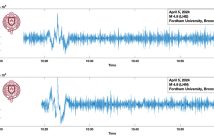During World War II, the United States Navy’s 10th Fleet helped coordinate the hunt for German submarines that had been threatening ships in the Atlantic Ocean.

Capt. Daryl R. Hancock Photo by Bruce Gilbert
On Aug. 4, Capt. Daryl R. Hancock told security experts gathered at Fordham’s Lincoln Center campus that the fleet, which was reactivated last January as “Fleet Cyber Command,” will play a similar role in protecting the nation’s online security.
“The ocean, just like cyberspace, can be used for peaceful purposes. Industry uses it for trade, for instance. But there are also pirates out on the ocean, and the same thing is true on the Internet,” Hancock said. “So we’ve got to be able to defend our networks in cyberspace.”
Hancock spoke at the end of the second day of the International Conference on Cyber Security (ICCS), a four-day event co-sponsored by the FBI.
As in its first iteration, the 10th Fleet is not a physical fleet of ships, but rather a base that supports Navy commanders in the areas of information, computers, electronic warfare and space operations. Hancock said the fleet is partnering with academia and private industry.
Among the fleet’s first challenges is to change the culture of the Navy, Hancock said.
“Right now, when our systems don’t work and our communications fail, we have kind of a breakage mentality. We’ll start swapping out equipment, thinking of it not as an intrusion, but as a failure of the system,” he said.
“We’ve got to change the mentality of our sailors to help them understand the importance of our networks and how we rely on them. We use them not just to get parts to our aircraft carriers; they’re also linked to our combat systems,” he said.
Hancock noted that the first shots fired in today’s major conflicts almost always happen in cyberspace, so within a few years, the systems on Navy vessels will be subjected to tests as vigorous as those administered to weapons systems.
Because, unlike the waters through which carrier groups sail, the cyber world is still relatively uncharted, Hancock said.
“We know all the aircraft flying thorough our battle space. We know what all of the ships are, and if we don’t, we go and find out,” he said.
“But in this domain, we don’t have that kind of situational awareness. We don’t have a good geographic display that shows how our networks are organized and where the connections are made. We’ve got to have a way of explaining that so our commanders can understand exactly what they’re looking at and where their vulnerabilities are.”


